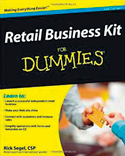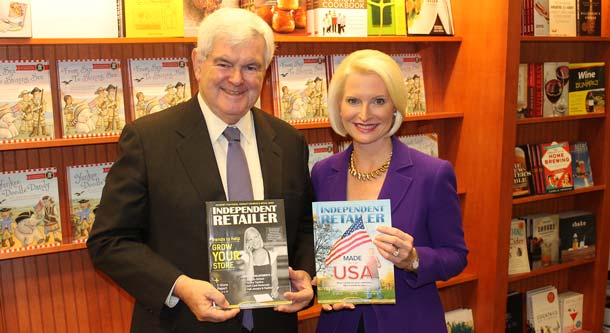
As 2015 unfurls before us, Independent Retailer is excited to offer you a comprehensive review of the industry outlook for the year. Here at IR, we are proudly celebrating our 25th anniversary in this fast-moving and ever-changing field, and we are even more pleased to share this groundbreaking 2015 retail forecast with you, our dedicated readers.
We have left no stone unturned in our quest to reach the best and brightest minds from across the American business spectrum to gather their thoughts and perspectives on the state of our industry – and what’s in store for the coming year. Each leader we’ve interviewed is uniquely positioned to provide a clear-eyed view of the business of retail, whether it be brick-and-motor, online, or a combination of the two. Their insights are both dramatic and edifying.
The integration of the Internet into our business and daily lives is responsible for much of the story of the revolutionary changes that have taken place since 1990. The rapid-fire growth of online retailing, social and mobile media has been head-spinning. That said, in the world of storefront retail there have also been massive technological improvements that have had an equally large impact on us all. From cash register and checkout technology, to security, barcoding and scanning, to CRM tracking of your customers and their habits, and much more, the daily functions of running a store have evolved greatly – yet in many essential, human ways, have remained quite the same.
 According to the US Bureau of Labor and Statistics, in 1990 the largest employer of workers was the manufacturing industry, with retail a close second. As the world changed and time marched on, the Baby Boomer generation aged and the Health and Human Services industry climbed into the top spot. Despite the ups and downs over time, however, retail remains a vitally strong and vibrant sector of the American economic powerhouse, and continues to drive creation of new jobs.
According to the US Bureau of Labor and Statistics, in 1990 the largest employer of workers was the manufacturing industry, with retail a close second. As the world changed and time marched on, the Baby Boomer generation aged and the Health and Human Services industry climbed into the top spot. Despite the ups and downs over time, however, retail remains a vitally strong and vibrant sector of the American economic powerhouse, and continues to drive creation of new jobs.
Michael Niemira, former director of research for the International Council of Shopping Centers and founder of economic forecasting firm The Retail Economist, has estimated that about 821,000 workers will be hired for retail seasonal jobs in the 2014 – 2015 season, up 11 percent from a year ago and the highest since seasonal hire record-keeping began – which, incidentally, was also 1990. This is great news, and a strong indicator of the endurance of our beloved world of retail. But, what of the future? What forces are at work now that will rise to the surface to drive changes for us? In looking at the history of retail and the current groundswells of the digital and mobile age, what can retailers expect in 2015?
To answer these questions we put together an all-star panel of experts from across multiple fields, including media, government, sports and, first and foremost, retail. From visionaries such as Newt Gingrich, former Speaker of the House, to the NFL Players Association and many more, we posed the same questions, and the responses we received are sagacious and revealing. In addition to the intriguing insights, we were able to spot several very clear trends that were common to all our panelists. We are certain you will relish reading through these enlightening observations and drawing your own conclusions.
Enjoy the 2015 Retail Outlook, and enjoy our 25th anniversary issue. Independent Retailer is here to serve your needs now and into the future, and, as always, to keep you informed on what is happening in the endlessly fascinating business of retail. █
![]() To survive and thrive as a small and passionate retailer, you should bring newness to your store, as often as possible—by continuously surprising and delighting your customers you’ll keep them coming back for more. While an independent retailer may not be able to build websites as costly as their larger counterparts, there is still significant opportunity and need to communicate with consumers digitally. Take time each day to email your best customers. It’s more effective to send 25 highly focused emails to your best customers than 1,000 emails that look and feel like a mass mailing. Finally, get creative with VIP offerings and how you promote them.
To survive and thrive as a small and passionate retailer, you should bring newness to your store, as often as possible—by continuously surprising and delighting your customers you’ll keep them coming back for more. While an independent retailer may not be able to build websites as costly as their larger counterparts, there is still significant opportunity and need to communicate with consumers digitally. Take time each day to email your best customers. It’s more effective to send 25 highly focused emails to your best customers than 1,000 emails that look and feel like a mass mailing. Finally, get creative with VIP offerings and how you promote them.
Independent retailers can compete in the long term, but you can’t rely on price as your sole differentiator. Be careful not to position yourself as a small “craft-like” company—unless you’re after craft consumers. Don’t be just another online retailer. Be a brand. Remember, the vast majority of highly successful websites are actually small companies, just like you.
To attract new business for online and brick-and-mortar, the rules are the same for both. Add product innovation. Focus on hiring and paying for the best talent, and do everything you can to keep them. And make customer engagement the top priority for every employee. In the US, 2015 can be a banner year.
As recruiters of management talent, we think our industry is a leading indicator of the broader business landscape. Companies add talent when they feel good about the future. Our executive search firm is entering 2015 with more work than we’ve ever had at the beginning of a new year. However, business won’t be good for everyone. There will be clear winners and losers. Those companies that are willing to change to match the times will win. Those who don’t will become victims of their own history. █
![]() Small business is personalized in the local environment in a way that’s very hard for larger companies. To survive and thrive as a brick-and-mortar, I would focus on my in-store experience and make sure I really understood my shoppers and what they wanted. I’d work hard to make the shopping experience innovative, powerful, and exciting. One thing I wouldn’t do is spend a lot of time competing on price. The real difference in the small retailer is customer service, so I’d spend my energy focusing there.
Small business is personalized in the local environment in a way that’s very hard for larger companies. To survive and thrive as a brick-and-mortar, I would focus on my in-store experience and make sure I really understood my shoppers and what they wanted. I’d work hard to make the shopping experience innovative, powerful, and exciting. One thing I wouldn’t do is spend a lot of time competing on price. The real difference in the small retailer is customer service, so I’d spend my energy focusing there.
Online retailers can compete by offering a range of unique products and services. In the next 10 years, retail is going to go completely global and digital. Companies will struggle with how to get their names and products known when they are competing with other companies around the world. The successful online companies will have extremely unique products, a very high level of cost awareness and control, and flawless distribution. They will work to find innovative ways to get their name out there, like working with Chambers of Commerce, online magazines, and being clear where their customers are.
Without an integrated, multi-channel approach, it’s going to be very challenging to grow in 2015. The important thing all retailers will have to know is how they’re shoppers are actually doing their shopping, and then meeting those shoppers where they’re at with products they really want.
The retail landscape in 2015 will experience a huge amount of channel fragmentation. We do not expect to see any big jump in spending or wages. Salaries are not expected to increase substantially. People are concerned about the cost of daily living—that won’t change in 2015. As a result, we expect to see intense combination driven by the combination of online and brick-and-mortar retailing. █
 People are accustomed to using “independent retailer” and “specialty retailer” interchangeably, but they are not the same thing. Specialty retailing is what you’ve got to do to reach the Millennial, who is the shopper of the future. They want an expert. So to survive and thrive as a brick-and-mortar, I would focus on letting people in my marketplace know I’m the expert. The problem comes when retailers say, “Of course we’re the expert,” when they’re actually talking about customer service. I’m not talking about customer service. I’m talking about educating your customers, using social media to give them tips and tricks on how to use your product and services. It sounds simple in principle, but it’s actually complicated.
People are accustomed to using “independent retailer” and “specialty retailer” interchangeably, but they are not the same thing. Specialty retailing is what you’ve got to do to reach the Millennial, who is the shopper of the future. They want an expert. So to survive and thrive as a brick-and-mortar, I would focus on letting people in my marketplace know I’m the expert. The problem comes when retailers say, “Of course we’re the expert,” when they’re actually talking about customer service. I’m not talking about customer service. I’m talking about educating your customers, using social media to give them tips and tricks on how to use your product and services. It sounds simple in principle, but it’s actually complicated.
If I’m seen as the expert, I don’t have to worry about what else is going on around me. Every bit of research shows that people will pay for expertise. If you’re an expert, people might try elsewhere, but they’ll return to you eventually. If you’re a store that produces free seminars, for example, you will exceed customer expectations. We’ve been trained to accept very poor customer service, so it doesn’t take much to delight people.
In order to attract new business and grow in 2015, people are going to have to look for ways to work together. Independent retailers, whether they are online or brick-and-mortar, will never have the cash to compete with Amazon, so they must find ways to cooperate. Also, loyalty is an incredible component of this. Customers will stay loyal if they get something back. What if independent retailers come together as a group of 100 and offer points toward purchasers at everyone in the group? That’s powerful. A few years ago, people were saying brick-and-mortar retailing is dead. I never agreed with that, and we’ve cycled back now. People want a real person to deal with. Online doesn’t know me as a customer or person. Websites make a lot of bad recommendations. So when someone walks into a store today, they’re saying, “I want more. Online isn’t as great as everyone says”. They are giving you a chance.
There was more money invested in brick-and-mortar in 2014 than we’ve seen in years. That will continue. There’s life and energy in this sector. I think malls can even make a comeback if they can build a community. Online will continue to grow because of the technology. More people are on smartphones than aren’t on smartphones. I think the biggest shift will be mobile devices moving into payment. Will this actually be good for brick-and-mortar and serve a conduit for payment? I think so, but I fear the independents will have a hard time keeping up with the big guys because of the costs involved. █
We are now facing the challenge of presentism. The challenge for small retailers both in terms of retail shopping, going out to eat, or getting gas is that most people like a sense of comfort – that they are going to a place they know, a place they trust, a place that knows them.
My wife and I go to the same shop to buy cards, and they already know what cards we want and which of us went in first to buy one. The best part about local retailers is the sense of knowing that we are going to go over to their store and the owners will see us coming and the employees know who we are – there is a sense of familiarity.
If you are a really busy person and you want something really fast and convenient then of course you go online, that will remain true. Online retail will be a substantial part of our future, but it will not be one hundred percent of our future … retail as we know it will survive.
“The best part about local retailers is the sense of knowing that …the owners will see us coming and the employees know who we are” █
 To survive and thrive as a brick-and-mortar store, I would be using social media and digital tools to promote my business. I would want to build great relationships with my customers. I’m thinking of a small toy store in my neighborhood that’s done a great job of getting to know me and my daughter. Those kinds of relationships are great for business and keep us coming back.
To survive and thrive as a brick-and-mortar store, I would be using social media and digital tools to promote my business. I would want to build great relationships with my customers. I’m thinking of a small toy store in my neighborhood that’s done a great job of getting to know me and my daughter. Those kinds of relationships are great for business and keep us coming back.
Online retailers can compete in the long term, but I think you have to really specialize and also know who your customers are. You need to tap into your true believers and really specialize so you can offer them products and expertise they can’t find anywhere else.
To attract new business and grow in 2015, you need to offer great products to customers you know. Reach out to your customers and let them know what’s going on. I welcome retail outreach if they are offering value to me. The tools are there, and this is where independent retailers have the advantage over the bigger guys. You can really get to know your customers individually and cater to them.
In general, I think the retail landscape is very healthy. It seems like the economy is pointing in the right direction, and I think that will only continue this year. I think we’ll see strong shopping as the year goes on. █
 If I were the owner of a small brick-and-mortar retail business, I would be looking at my margins and how my reliance on discounts might be making my profitability worse, because I’ve been using it for so long I’ve become blinded to it. It’s easy to look at sales numbers but you really have to look at the margin numbers at the end of the year to plan for 2015, then find vendors where you can get a better margin.
If I were the owner of a small brick-and-mortar retail business, I would be looking at my margins and how my reliance on discounts might be making my profitability worse, because I’ve been using it for so long I’ve become blinded to it. It’s easy to look at sales numbers but you really have to look at the margin numbers at the end of the year to plan for 2015, then find vendors where you can get a better margin.
I’m a brick-and-mortar guy so I honestly don’t think online retailers can compete in the long term. The reality is you are going up against Amazon, and they getting smarter by the second – their algorithms, buying patterns, predictive buying, storing credit cards, new apps, new features — people can bid for lower prices on Amazon, taking the best deal. More people search first on Amazon than online. It’s punishingly tough especially if you aren’t devoting the necessary resources to it. Thirty years ago you could set up shop on the web and make a good deal, now many of these online deals are proving to be not-so valid. As that becomes more transparent, the only way to survive will not be by price but with convenience, and Amazon owns that.
To attract new business and grow in 2015, both brick-and-mortar and online retailers have to have such an incredible customer experience that you essentially brand your customers with your brand. If they need something, then they come back to you. That’s honestly harder online than in brick-and-mortar because online is a game of seconds, and of pennies, whereas if you are a great retailer that is reliable – and doesn’t open on Sundays, people will put up with that – but there is a lot that people won’t put up with online. It’s always going to be the customer experience. Business is only successful with people, which are not represented in online sites. They just buy templates from a few companies that make their stores look like everyone else’s.
I think the retail landscape for 2015 is healthy. There will be a big shakeout if you are a teen retailer, it’s awfully scary, and some are declaring bankruptcy and are really struggling. The reason that’s a bigger concern for most of us is that’s probably a generational shift. Millennials are buying things used and on Craigslist and eBay. The hope I take is 70 percent of baby boomers control the total income so we need to cater to them. And for that reason we aren’t going anywhere, most of us are still employed, we’re not retiring. I think consumer confidence is up and I think it’s going to be a good 2015.
From my end I have all my sales training online and more retailers are coming to it. The only way to be successful is with the customer experience and people are realizing that. In light of black Friday not working, the best retailers are recognizing they are successful because of people. Technology comes and goes, and apps and all this other garbage, but if you don’t get the people right, nothing works. How do they make better choices of hiring? How do they get people who never worked in retail the correct skills to succeed? To see those people deliver those skills with confidence? That will deliver the ROI they need. █
If I owned a smaller brick-and-mortar business, I would look to leverage my existing customer base, focus on lower cost marketing programs, increase brand awareness and try investing in my brick-and-mortar capabilities as much as possible. Social media is cost effective and a great way to demonstrate amazing customer service, while simultaneously increasing brand awareness and engagement, for a lower marketing cost. I would get a lot of “bang for my buck” with a detailed social media campaign, including most likely Twitter, Facebook, Instagram and Pinterest. Wherever my customers are on social media (whichever platform), is where I would need to be. And there are many free social measurement tools available today as well.
I would also try to maximize my cross-channel presence as much as possible, focusing on programs like in-store pick-ups and returns. These programs may be cost prohibitive, but if there is any way to assist cross-channel shoppers to complete the purchase, it is worth the investment. Secondly, I would focus heavily on customer retention and loyalty, and ensure that I have some type of loyalty program in place. The loyalty program should be cross-channel (in-store, online, even advertising via social media) to ensure that I am keeping customers engaged, and keeping them aware of new promotions and incentives through this program. Lastly, I would try and leverage local search capabilities on Google and partner with other small businesses nearby to perhaps use each other’s sites as a means of driving traffic. Having strategic partners who can assist with advertising would be great for my business, but the audience would need to be pre-qualified.
There are a number of online-only retailers who are not only competing today, but also truly thriving. Some have adopted some sort of offline presence after establishing their online presence, whether it is pop-up shops, etc. They have a distinct advantage in that they are nimble and flexible enough to be able to respond to customer needs and adopt newer technologies that could be game changing. They can truly be on the “cusp” of innovation. Additionally, “off the shelf” technology is helping to level the playing field in terms of order fulfillment and marketing automation for online only retailers, so that they can actively compete with their larger counterparts.
In terms of attracting new business in 2015, mobile is really the answer here. If a retailer has not figured out whether they should have a mobile app, a mobile site, or both, or they have not investigated responsive design – they will most likely be missing out on valuable traffic and customers. The ubiquity of mobile devices is forcing some retailers to even think with a “mobile first” mindset. It’s really about obtaining data around what need your brand services for your customers, what is their shopping behavior, and how you can service those needs. More than likely, mobile needs to be a huge part of your strategy not only now, but in the future, as this space is only going to mature.
I believe the retail landscape will continue to be healthy in 2015 and in the future, especially in terms of the growth of online retail. We’ve had some really positive news in terms of unemployment numbers and job reports as of late, a very healthy holiday season and as long as the economy remains in an expansion mode, retail should remain healthy as well. Multi-channel and/or Omni-channel commerce will continue to grow as well. This industry is so fast paced that those who cannot adapt and truly “put the customer first” will not succeed. And with a company like Amazon, many retailers are constantly thinking about capturing market share, driving loyalty with customers and ensuring they can exceed customer expectations. █
If I were the owner of a small brick-and-mortar retail business, I would definitely make sure my online presence was strong. I would make sure I had a website that was ready and available to accommodate my customers. Websites also need to be well equipped enough to reach customers on all levels whether it be through a computer, or through smartphones and tablets. I would also devote time to beefing up my stores social media pages and create a local following.
I think online retailers can definitely compete in the long term because these days retailers are establishing themselves online to avoid the costs of renting out a store. Designing the layout, filling the store with product, all this work and the truth is people can do that same thing online. Things move so rapidly to mobile — cellphones, smartphones, iPads – it would be silly for retailers to do business offline unless you had a unique product that you know will succeed in a physical store. People nowadays see things online and just automatically buy it. I believe smaller online retailers have nothing to worry about; it is just a matter of how they execute their online strategy.
In order for online and brick-and-mortar stores to attract new business and grow in 2015, they both need to harness the power of social media. It is extremely important because people are not going to destinations to socialize anymore like in the 80’s or 90’s; people are interacting online. If these retailers do not recognize that people are gathering in online communities, and cater to that, they will lose business.
I think the retail landscape is healthier than what we have seen in the past few years. Compare to 2007 or 2008, this is much healthier, but it is nowhere near what it was pre-recession. There have been many economic issues that have impacted spending. The retail landscape will be fine, and hopefully become better as the consumer feels more confident about the future of retail as well.
Retailers will succeed the most when they have adopted the idea of Omni channel retailing. When this was first brought up in 2009, no one understood what it was and now that has completely changed. If you are a brick-and-mortar retailer then you should be driving sales from all channels – flyers, emails, and mobile devices. Retailers cannot ignore Omni channel. When they realize that, and can drive traffic and sales from every angle, that will determine their overall success as a business. █
To survive as an owner of a brick-and-mortar retail business, it is about finding ways to connect with customers outside of your four walls, and then using those ways to drive people into your store. As products become more commoditized, the storefront is where you can differentiate yourself. The store is not about products; it is about being different and how you connect with customers. This is one advantage brick-and-mortar stores have over online retailers right now.
For online retailers, I would focus on building a community. You need to build affinity for your brand. You are not going to be able to compete with the big brands on price and even assortment. Instead, you need to create brand advocates with a digital engagement strategy. For example, outside of the United States, Dominoes Pizza has put the power in the hands of consumers with an app called Pizza Mobile. This app allows you to create your own pizza and order it from your phone, but they have taken it further. You can put your pizza on the Dominoes’ website and sell it, and then you collect a commission every time someone buys your pizza. They have got people who have made $37,000 selling Dominoes pizza. Customers have started doing their own advertising. All of a sudden, Dominoes has got thousands of people out there selling pizza, and their customers drive it all.
To attract new business and grow in 2015, it is really about understanding who are your core customers. A lot of retailers do not have a concise view of that. You need to recognize who your customer is and which things you do really well and which things you do not do so well. Do not worry about perfection and never be afraid to try lots of different things. Customers will interact with your brand through technology; you see it in the way apps are constantly being updated. There is a difference in the way customers approach technology today, it is a much more iterative approach. So figure out how to build that into your customer interaction strategy and experiment with it.
I think the retail landscape is a mixed bag next year for a couple of reasons. Clearly, the US economy is strong right now, with consumers spending again. But the flip side is that the US dollar is strong relative to other currencies, so we are seeing reduced spending from overseas tourists. I think in the coming year, we will also see a lot more happening that is going to make it easier to transact with retailers. You hear about it with mobile payments and things like frictionless retail. Everyone is coming around to the reality that we need to think about in-store, out-of-store, and online selling. It is Omni-channel retailing. █
 If they have not already, small brick-and-mortar retail businesses need to start promoting themselves online. The easiest way to do that is by shifting some of their marketing budget from traditional advertising to digital marketing venues. The line between offline and online behaviors is quickly blurring, and so brick-and-mortar stores must move toward digital. Additionally, I would recommend these small retail businesses revisit their technology choices. Mobile payments are going to be huge and there are technology choices that can combine POS, e-commerce, and mobile payments all in one. Moving forward, the key for brick-and-mortar retailers is finding ways to simplify their processes.
If they have not already, small brick-and-mortar retail businesses need to start promoting themselves online. The easiest way to do that is by shifting some of their marketing budget from traditional advertising to digital marketing venues. The line between offline and online behaviors is quickly blurring, and so brick-and-mortar stores must move toward digital. Additionally, I would recommend these small retail businesses revisit their technology choices. Mobile payments are going to be huge and there are technology choices that can combine POS, e-commerce, and mobile payments all in one. Moving forward, the key for brick-and-mortar retailers is finding ways to simplify their processes.
Independent online retailers can absolutely compete in the long term. Consumers are looking to keep dollars in their local community more than ever before. However, the independent retailer has to invest in being top-of-mind for those consumers and keeping their brand in the forefront of their customers when making buying decisions.
Attracting new business growth is directly related to the survival of small business retailers. Again, making the move to digital is imperative. They need to have a web presence with a site optimized for SEO. They need to take advantage of the viral reach of Facebook, Pinterest, Instagram, and Google Plus. However, in doing so, it is important to recognize and understand that success with these networks comes at a price and they’ll need to invest in online ads.
There are definitely some very healthy verticals within independent retail, and those that are healthiest understand the need to continue improving and stay abreast of the newest trends. They understand the importance of proactive marketing, and know that it is well worth their investment of their time and their money. This doesn’t mean they need to sacrifice other aspects of their business. There are many affordable and easy-to-use marketing solutions today that allow their brands to compete with the big chains. █
To survive and thrive as a brick-and-mortar retail business, retailers have to be much more aggressively scouring the market for unique and interesting product. They need something you’re not going to find all over Amazon. The brick-and-mortar guy has to be unique and interesting selling what no one else has. They need to carefully plan their purchasing to get most cash flow out of the business. Also concentrating on email marketing and in store events, which statistically drive more traffic than anything else.
Independent online retailers can compete in the long term if they have unique distribution and pricing advantages. Otherwise the Amazons of the world will swallow them up. To attract new business and grow in 2015, well how does anybody grow? Both brick-and-mortar and online retailers need to be attacking new markets, have new product development and new styles of distribution.
The retail landscape for 2015 will be healthy for the people paying attention to the numbers– watching stats, following an open to buy plan, using numbers to make the most cash out for the freshest inventory. The need to be agile in the marketplace, and those will be the retailers with great success in 2015. I have no concerns for those independent retailers, they are sure to flourish in 2015.
Retailers have to remember inventory is their biggest investment. Not enough retailers spend enough time studying investment. Retailers need to spend time seeing where their growth potential is, seeing where they need to play offense and defense. That will lead to their ultimate success. █
To survive and thrive as a brick-and-mortar retail business I would do an immediate audit of where I was with mobile technology and social media. Do I have an app? If not, why not? Do I show up in Google? Have I maximized location intelligence? If you aren’t doing these things, you’re doing something wrong. I think a lot of small businesses think they’re too small to use social media and online tools, but no one is too small to participate and maximize their visibility in the social world.
It’s impossible to compete with the big guys in the long term unless you have a niche product or really have a distinct value proposition. You have to be very different. If you’re selling food, carry unique food items or carry local crafts. There are many ways to do this, but as time goes by it’s becoming increasingly difficult.
Cell phones are increasingly critical to the world. To attract new business and grow in 2015, explore and understand the rising trend of shopper marketing, or marketing to people on their cell phones while they are actually in your store. Experiment with different approaches and take advantage of the tools that are out there. Think big. Start small. Scale fast.
People suffer from something I call short-termism. Any time I’m traveling in North America, I hear people saying that we’re suffering and the economy is awful. But everyone is driving nice cars and we’re all still shopping. I think the problem is there’s a lot of defeatism out there, and I think it’s because people are overwhelmed by the speed of change. You have to be willing to adapt and be innovative and win customer loyalty. It’s a mindset, and you have to change your attitude. █

 Les Berglass
Les Berglass Thom Blischok
Thom Blischok Rick Segel
Rick Segel Newt Gingrich
Newt Gingrich Steve Scebelo
Steve Scebelo Bob Phibbs
Bob Phibbs Lori Hawthorne
Lori Hawthorne Hitha Prabhakar
Hitha Prabhakar Robin Copland
Robin Copland Tara Ronel
Tara Ronel Dan Jablons
Dan Jablons Jim Carroll
Jim Carroll